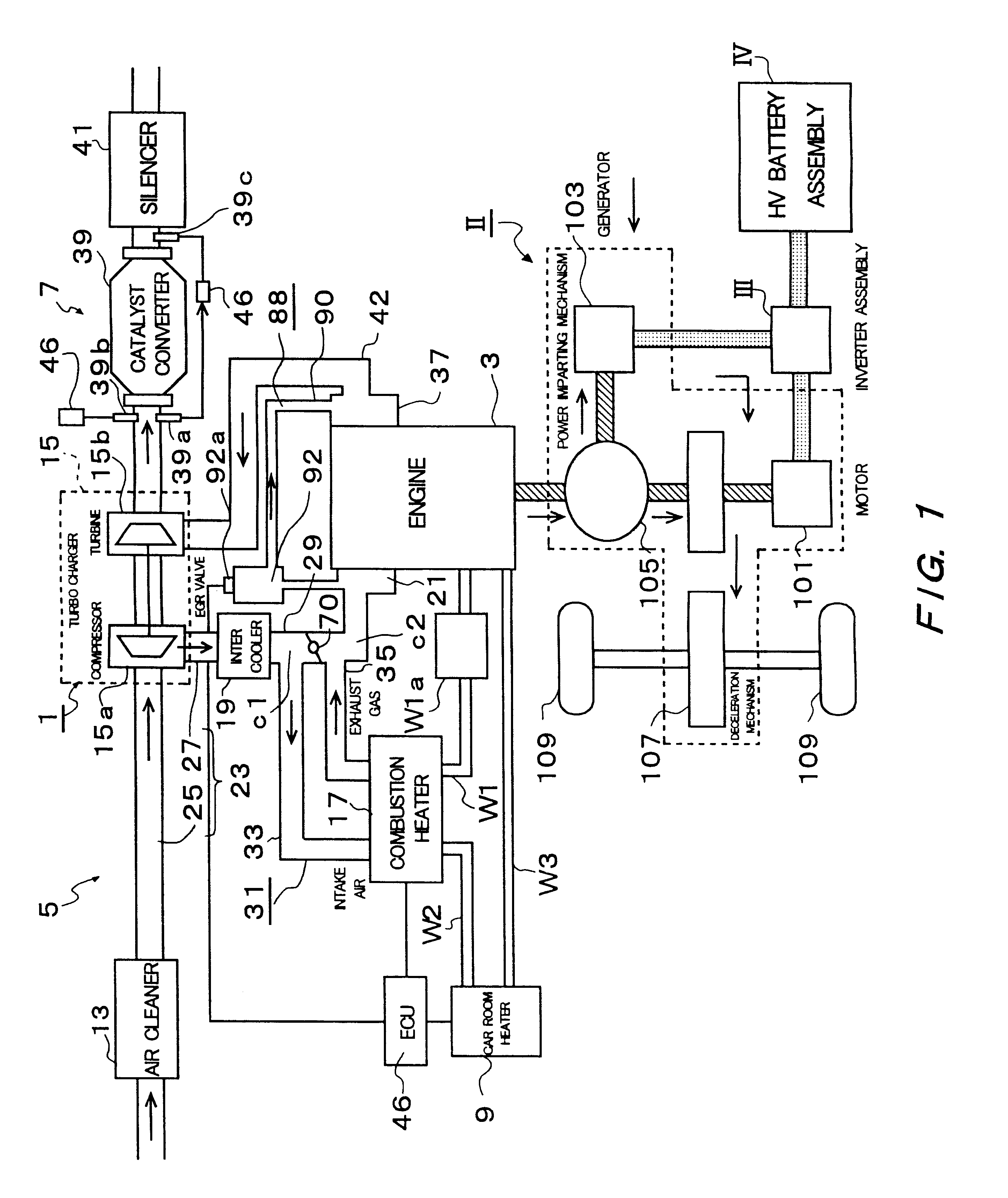Exhaust emission control system of hybrid car
a technology of exhaust emission control and hybrid cars, which is applied in the direction of machines/engines, combustion-air/fuel-air treatment, transportation and packaging, etc., can solve the problems of not being able to effectively activate the catalyst, the catalyst cannot function effectively, and the load on the engine fuel injection device increases
- Summary
- Abstract
- Description
- Claims
- Application Information
AI Technical Summary
Benefits of technology
Problems solved by technology
Method used
Image
Examples
first embodiment
the present invention will be discussed referring to FIGS. 1-3.
(Outline of System Architecture of Hybrid Car)
What is shown in FIG. 1 is a system architecture of a hybrid car which travels by two types of power sources of an engine and a motor. This system architecture includes a diesel engine I functioning as a main power source of the hybrid car, a hybrid-oriented Trans-axle II including an electric motor 101 functioning likewise as a sub-power source, an inverter III for controlling the electric power to the electric motor 101, and a battery IV for supplying and collecting the electric power by a predetermined voltage. Note that neither the inverter III nor the battery IV is related directly to the present invention, of which detailed explanations are therefore omitted, and the diesel engine I and the hybrid-oriented Trans-axle II will hereinafter be discussed in details.
(Diesel Engine I)
A diesel engine 1 serving as an internal combustion engine has an engine body 3 equipped with ...
second embodiment
The exhaust emission control system of the hybrid car in a second embodiment will be described with reference to FIGS. 5-7.
The followings are differences of the second embodiment from the first embodiment. A difference (1) is that the heater branch pipe 31 is connected to the upstream-side connecting pipe 25, instead of being connected to the mainstream pipe 29 of the downstream-side connecting pipe 27 in the first embodiment. A difference (2) is a branch pipe 95 provided midways of the combustion gas discharge passageway 35 and extending downstream of the intake throttle valve 70. A difference (3) is a three-way valve 97 provided, as a valve device which opens only when the combustion heater is operated, at a diverging point of the combustion gas discharge passageway 35 to the branch pipe 95. Therefore, the same components are marked with the like numerals, and their explanations are omitted.
As shown in FIG. 5, the heater branch pipe 31 is connected to the upstream-side connecting ...
third embodiment
The exhaust emission control system of the hybrid car in a third embodiment will be described with reference to FIGS. 8-10.
The followings are differences of the third embodiment from the second embodiment. A difference (1) is a provision of a combustion gas passageway 99 diverging from the branch pipe 95 and extending anterior to the catalyst 39 of the exhaust pipe 42. A difference (2) is that a three-way valve 97' is added at a branch pipe 95 connecting point between the combustion gas passageway 99 and the branch pipe 95, and there are provided two pieces of three-way valves designated respectively by 97 and 97'. Hence, the same components are marked with the like numerals with an omission of their explanations.
(Combustion Gas Passageway 99)
The combustion gas passageway 99 serves to send the combustion gas, which comes from the combustion heater 17 and arrives at the branch pipe 95 via the three-way valve 97, towards anterior to the catalyst 39 without letting this combustion gas ...
PUM
 Login to View More
Login to View More Abstract
Description
Claims
Application Information
 Login to View More
Login to View More - R&D
- Intellectual Property
- Life Sciences
- Materials
- Tech Scout
- Unparalleled Data Quality
- Higher Quality Content
- 60% Fewer Hallucinations
Browse by: Latest US Patents, China's latest patents, Technical Efficacy Thesaurus, Application Domain, Technology Topic, Popular Technical Reports.
© 2025 PatSnap. All rights reserved.Legal|Privacy policy|Modern Slavery Act Transparency Statement|Sitemap|About US| Contact US: help@patsnap.com



